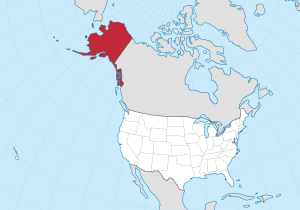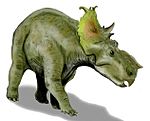Paleontology in Alaska facts for kids

Paleontology in Alaska is all about studying fossils found in the U.S. state of Alaska. It also covers the research done by people from Alaska. Long, long ago, in the Late Precambrian time, Alaska was covered by a shallow sea. This sea was home to tiny bacteria that formed stromatolites, which are like layered rocks made by microbes.
Alaska stayed under the sea through the Paleozoic era. During this time, the ocean was filled with amazing creatures. These included ammonites (shellfish with coiled shells), brachiopods (shelled animals), and corals that built large reefs. Later, a chain of islands grew in the eastern part of the state.
Even during the Triassic and Jurassic periods, Alaska was mostly covered by seawater. The ancient seas were home to more ammonites, belemnites (squid-like animals), bony fish, and ichthyosaurs (marine reptiles that looked a bit like dolphins).
By the Cretaceous period, Alaska had much more dry land. It was a place with lots of different plants and many kinds of dinosaurs!
In the early Cenozoic era, Alaska had a warm, subtropical climate. Over time, sea levels dropped, and a land bridge appeared, connecting Alaska to Asia. Early humans walked across this bridge. We know this because scientists have found woolly mammoth bones from that time that show signs of being cut by human tools.
More recently, Native Americans often explained local fossils through their mythology. By the 1830s, trained scientists started paying attention to Alaska's fossils. Some important finds include the Kikak-Tegoseak Pachyrhinosaurus bonebed, which is a place where many bones are found together. The woolly mammoth, Mammuthus primigenius, from the Pleistocene Ice Age, is now the official state fossil of Alaska.
Contents
Ancient Alaska: A Look at Prehistoric Life
Early Seas and Island Chains
During the Late Precambrian time, Alaska was covered by a shallow sea. This sea was home to tiny bacteria that formed stromatolites. These stromatolites later turned into fossils. Most of Alaska continued to be covered by the sea. By this time, the state was home to brachiopods and trilobites.
During the Ordovician and Silurian periods, a chain of volcanic islands formed in what is now eastern Alaska. These islands appeared because of how the Earth's tectonic plates were moving. Coral reefs grew in the seas around these islands.
The northern part of Alaska stayed covered by seawater from the Devonian to the Permian periods. Marine life there included ammonites, brachiopods, corals, and gastropods (snails). Scientists have found at least 34 different kinds of gastropods from late Paleozoic Alaska. Nine of these were completely new to science when they were first discovered!
Triassic and Jurassic Marine Worlds
In the Triassic period, the sea grew even larger. Northern Alaska was under deep water, while southern Alaska had a shallow sea. The Triassic seas of Alaska were home to bony fish, ichthyosaurs, and different kinds of mollusca. Volcanoes were very active in Alaska during this time.
Volcanic activity continued into the Jurassic period. Alaska experienced a lot of geological changes. Parts of the state were still covered by the sea. This sea was home to ammonites and crinoids (sea lilies). In the middle Jurassic, most of the mountain ranges we see in modern Alaska began to form.
Fossils from Alaska's Middle Jurassic period are part of a huge area that stretches through Canada and into other U.S. states like Montana and Idaho. From the mid to late Jurassic, the area now called Snug Harbor was full of many different marine invertebrates (animals without backbones). They left behind many fossils, including ammonites, belemnites, the gastropod Amberlya, and several types of clams like Lima and Oxytoma.
Cretaceous Dinosaurs and Plants
During the Cretaceous period, Alaska gained more land as tectonic plates collided. This movement also created the Brooks Range and other mountains. Some parts of Alaska were covered by sea, while others were dry land.
Scientists have found at least five species of Inoceramus (a type of clam) in Cretaceous Alaska. This clam was very common, and its fossils have been found in hundreds of places. Other Cretaceous shellfish were preserved at Umiat Mountain.
More than 235 species of plants are known to have grown in Alaska during the Cretaceous. Most of these were cycads, which are ancient palm-like plants. Their remains are found across hundreds of sites. These plant fossils include algae, conifers, elm, laurel, magnolia, oaks, and sequoias. Fossils of invertebrates were also found with these plants. Pieces of Cretaceous amber (fossilized tree resin) have been found on Nelson Island in the Bering Sea.
And yes, dinosaurs lived in Alaska during the Cretaceous period!
Ice Ages and Land Bridges
Alaska continued to be geologically active into the Cenozoic era. Volcanoes created the Aleutian Islands. During the Eocene epoch, Alaska's plants were similar to those growing in warm, temperate, subtropical, and tropical places today. Their fossils have been found in places like the Alaska Peninsula and Cook Inlet.
Alaska's land area grew to almost its modern size from the Miocene to the Pliocene epochs. During times when sea levels were low, a land bridge connected Alaska and Asia. This allowed animals to move between the two continents.
Large parts of Alaska were covered by huge glaciers during the Quaternary period (the most recent geological period). Volcanic activity also continued. In Alaska, Pleistocene mammal fossils, like those of mammoths, are often found with tools left by early humans, such as the Folsom people.
Discovering Alaska's Ancient Past
Early Scientific Finds
Since 1836, at least five mammoth discoveries have been made in Alaska. One of the earliest was in 1897, when mammoth bones were found in a volcanic cave on St. Paul Island. This was so unusual that some scientists wondered if it was a practical joke!
In 1850, an important step in Alaskan paleontology happened with the first publication about the state's Tertiary plants. These plant fossils were first found in places like the Alaska Peninsula and Unga Island. Between 1902 and 1908, hundreds of places with Cretaceous plant fossils were discovered. These included algae, conifers, elm, laurel, magnolia, oaks, and sequoias. Invertebrate fossils were also found with the plants.
In 1903, more Tertiary plant fossils were found between Awik and Eagle City. In the 1930s, several long scientific papers shared even more information about Alaska's Cretaceous plants. It took about 50 years after the Tertiary plants were studied for the Cretaceous plants to get serious scientific attention.
No more mammoth remains were found until 1952. That year, a partially fossilized mammoth tooth was discovered. It weighed 3 pounds and 11 ounces and was 9.75 inches long! In the mid-to-late 1900s, the University of Michigan tried to find Cenozoic vertebrates in Alaska, but after three attempts, they stopped.
Dinosaur Discoveries
In 1994, a duck-billed dinosaur fossil was found in a quarry near the Glenn Highway, about 150 miles northeast of Anchorage. Workers were digging for road material in the Matanuska Formation. This fossil, called the "Talkeetna Mountains Hadrosaur," was the first connected skeleton of a single dinosaur found in Alaska. It came from a new place where high-latitude (far north) dinosaur fossils had not been found before.
That same fall, paleontologists started digging up the fossil. More work was done in the summer of 1996. The fossil is now kept at the University of Alaska Museum. Scientists learned that the Talkeetna Mountains Hadrosaur was a young dinosaur, about 3 meters (10 feet) long. However, the fossil didn't have enough detail for them to tell if it was a hadrosaurid or lambeosaurid (two types of duck-billed dinosaurs).
Another important discovery in 1994 was made by a University of Alaska team searching along the Colville River. They found fossils at the bottom of a bluff over 100 meters tall. In 1997, D. W. Norton and a student named Ron Mancil traced the fossils to the top 3 meters of the bluff.
From 1998 to 2002, the Museum of Nature and Science worked with the University of Alaska to dig at this site. It is now known as the Kikak-Tegoseak Quarry, part of the Prince Creek Formation. The dig uncovered a new dinosaur bone bed, mostly filled with bones from an unknown species of Pachyrhinosaurus. The United States Army helped the researchers in 2002.
The harsh climate in Alaska meant the fossils were broken into many pieces. This made the scientists change their digging plans. After preparing a new approach, they started digging again in 2005 and finished at the end of the 2007 field season. The fossils were lifted out of the quarry using a sling attached to a U.S. Army Bell 206 JetRanger helicopter. These fossils are now kept at the Museum of Science and Nature.
Places to See Fossils: Natural History Museums
If you want to see Alaskan fossils, here are some museums:
- Department of Paleobiology, Smithsonian Institution, Washington, D.C. (This museum has the largest collection of Alaskan fossils, many from the USGS.)
- Alaska Geologic Materials Center (GMC), Anchorage, Alaska. (This center has many collections from the oil industry and the State Geological Survey, including tiny fossils called foraminifera and palynomorphs.)
- Alaska Museum of Natural History, Anchorage
- Alaska State Centennial Museum, Juneau
- University of Alaska Museum of the North, Fairbanks
- Pratt Museum, Homer



